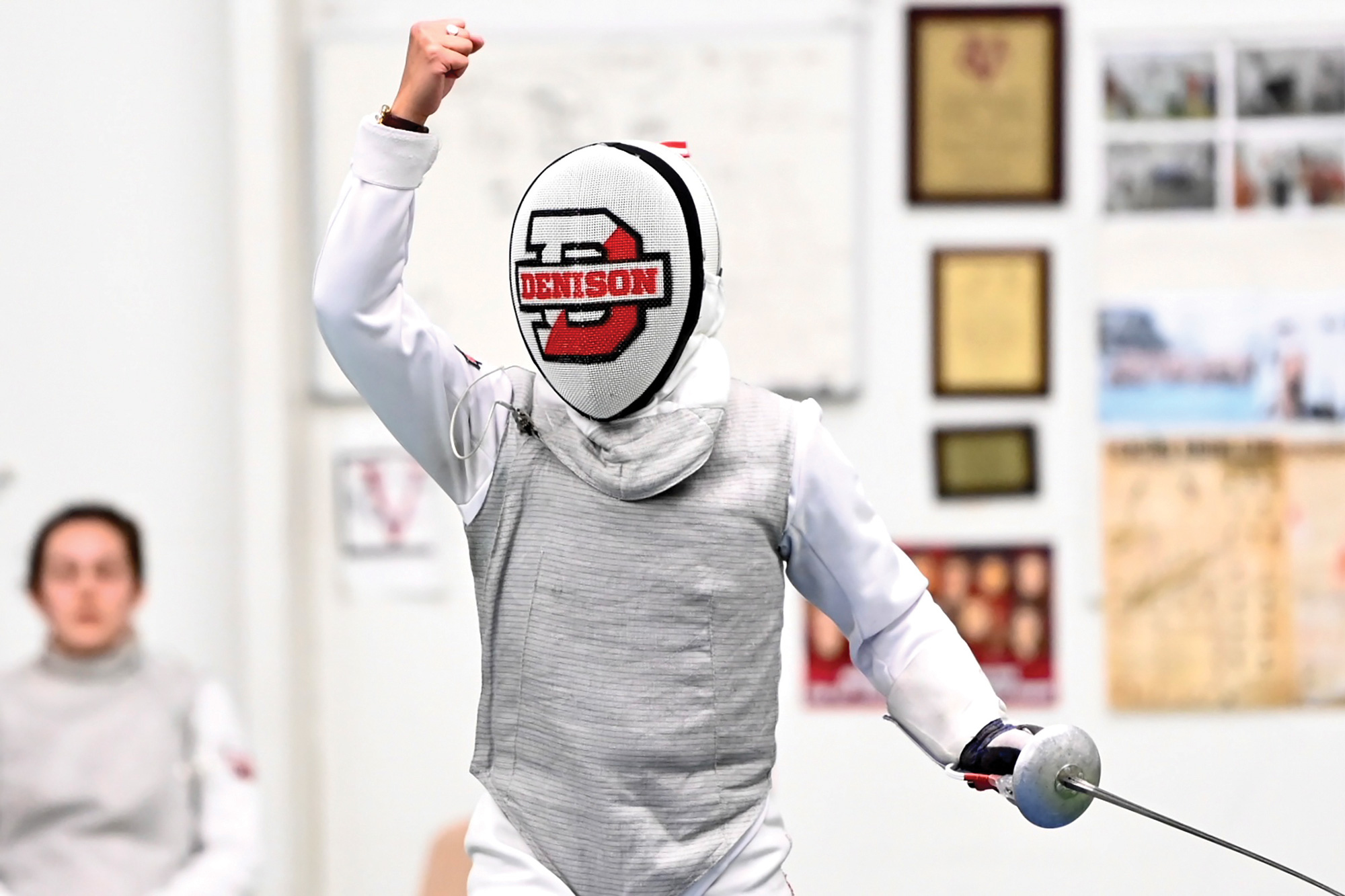It’s that old cliche: the English professor who writes books and coaches sword fighting.
Wait, sword fighting?
You won’t often find a résumé like that of Peter Grandbois. He teaches creative writing and journalism at Denison and has written 13 books. He also started the university’s fencing team from scratch and coaxed it into a growing varsity program.
In 2011, soon after hiring on at Denison, Grandbois poked around and discovered an old locker full of fencing equipment from the ’80s — the suits and masks that make fencers look a bit like armed beekeepers. It turns out Denison’s fencing history goes decades back. It fielded a club team at the first NCAA championships in 1941, Grandbois says, but the student-run club eventually fizzled out.
“I’m excited to keep that history alive,” he says. “Already four years into our women’s varsity program and I think we have potential to return to the NCAA national championships in the next couple years. When that happens, Big Red fencing will have come full circle.”
An early passion
Grandbois has a habit of starting fencing programs. His love for fencing stems back to his childhood when he would fake illness to skip school and watch a good sword-fighting movie.
He encountered the sport in college and became so passionate about it that he extended his college career to continue fencing, earning a master’s in literature along the way.
His ability earned him a spot on the national team, but eventually, Grandbois shifted into teaching. At Adlai Stevenson High School in Chicago, he started a fencing program in the early ’90s that he says quickly became the biggest team in the school.
Following that pattern, not long after he came to Denison Grandbois began plastering campus with flyers in an effort to start a team. He supplemented the meager supply of equipment with his own gear.
The club team started small and fluctuated but grew into a program that now features a men’s club team and a women’s varsity team that’s drawing increasing interest and playing some of the top teams in the country.
“Peter is just such a wonderful reflection of incorporating athletics in the liberal arts,” says Nan Carney-DeBord ’80, Denison’s athletic director. “It’s in line with the athletic department’s focus on academics. To have a full professor publishing books and coaching a varsity sport? If that is not a symbol of the quintessential experience in the liberal arts, I don’t know what is.”
From the ground up
While sports like football usually draw an elite few, Grandbois took pretty much all comers as he cobbled together the fencing teams at Denison. His first varsity team had only one fencer with prior experience.
Cinema major Paige Cromwell ’24 was one of the novices. She had no idea that fencing was in her future when she arrived at Denison, and in fact was not all that into sports. But early in her first year, friends who were part of the club team invited her to join.
“I thought it would be fun to go just to try out a combat sport,” she said.
Her hunch was right. She loved it. Grandbois soon tapped her for the varsity team.
Cromwell says she enjoys the thrill of competition and having a team behind her. She liked it so much that when she had to pick between fencing and another class — one closer to her major — she went with fencing.
Given that Grandbois didn’t pick up fencing until college either, he’s open to welcoming inexperienced team members. He also says he’s determined to keep the club option going.
“I want people to be able to start even later in life, because not everybody gets the chance to do it early,” he says.
Grandbois credits the program’s culture for the way even new fencers thrive. The fencers embrace self-confidence in the face of risk and build trust with each other. When that happens, he says, “they can do some pretty amazing things.”
When literature meets fencing
The risk of diving into a new and difficult sport has parallels with the field of English, Grandbois thinks, and he emphasizes that with the fencers.
“Willingness to fail is so crucial in both fields,” he says. “And both require creativity and spontaneity. They say it takes one lifetime to learn the basics of fencing and the next lifetime to master it. I would say the same thing for creative writing.”
He’s seen many talented writers and fencers quit as soon as things get hard. Focusing on mastering a tough craft gives you the confidence to carry on, he says.
It helps to have a guide and mentor. Nina de Laperouse, a biology major, is a varsity team member and has taken a creative writing class with Grandbois. He brings the same approach to both, she says: energy, encouragement, and availability when help is needed.
Fencing departs from the creative arts with its athletic demands, though: “There’s a lot of technique and a lot of work that’s involved with fencing,” de Laperouse says. “It’s not just us moving around and swinging swords.”
De Laperouse, who picked up fencing in high school, represents a shift in the program, which has begun to pick up steam and bring on more experienced fencers. The women’s team finished the end of last season with nine fencers, Grandbois says (four left to study abroad), but this year is up to 21.
And the newcomers add fencing chops. “It’s so cool to see,” Cromwell says. “Some of these freshmen just absolutely demolished me.”

